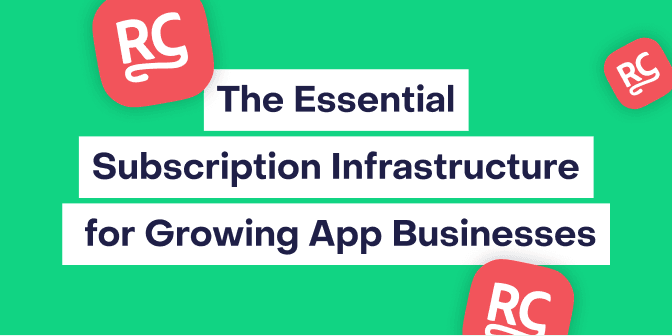As competition intensifies across the mobile app ecosystem, more developers and companies are turning to subscription models to create sustainable revenue and accelerate growth. In-app purchases and subscriptions are now core monetization strategies for many of the world’s leading mobile businesses.
But managing subscriptions isn’t easy. Server-side receipt validation, cross-platform entitlements, centralizing data across app stores, setting up pricing experiments, tracking performance, all of this requires time, technical resources, and constant maintenance. That’s where RevenueCat comes in.
RevenueCat is a cross-platform solution for leveraging in-app purchases and subscriptions. It provides versatile SDKs, scalable infrastructure, and a robust analytics and experimentation toolkit as a platform, so you can focus on building and growing your app, not wrangling with store APIs.
Today, more than 75,000 apps across industries like gaming, health, education, and dating rely on RevenueCat, processing over $11 billion in annual subscription revenue. From indie developers to global companies like OpenAI, Notion, and Buffer, teams of every size use RevenueCat to simplify monetization and accelerate growth.
Why do global companies use RevenueCat?
RevenueCat delivers distinct, but ultimately complementary, value to developers, growth marketers, and product managers.
1) Developer perspective — Cut the Cost and time of building subscription infrastructure
- Receipt validation & entitlements without a separate server: RevenueCat securely validates App Store / Google Play receipts on its servers and exposes results as simplified Entitlements. On the app side, you only need to check: “Does this user have the pro entitlement?” No separate backend for payment verification required.
- Cross-platform SDKs with a consistent model: RevenueCat abstracts platform differences so you work with the same concepts, customer, purchase, entitlement everywhere. Android’s Google Play Billing and iOS’s StoreKit evolve annually; migration and testing are costly. RevenueCat handles this, dramatically reducing maintenance across platforms.
- Remote configuration with Offerings/Packages: Update price plans, display order, messaging, and trial availability from the dashboard, no code changes or redeploys. You can move faster on marketing and business strategy while developers focus on higher-value engineering work, and avoid constant back-and-forth for A/B tests.
- Paywalls & Experiments: Non-developers can edit UI/copy/pricing for paywalls and offerwalls in a Figma-like web editor. You can assemble screens and run A/B tests in native Android/iOS without code changes, skipping the long cycle of code → release → review → user update. This is especially valuable on iOS, where reviews can take 1–2 weeks even for small copy tests.
- Edge-case handling built in: Sandbox, refunds, upgrades/downgrades, restore purchases, subscription complexity often comes from exceptions. RevenueCat standardizes state transitions, so your team can focus on monetization and core business logic. For example, when a user buys on device A and logs into device B, restoring access is straightforward.
- Reduced security/policy burden: RevenueCat addresses receipt tampering, changing store policies, and other sensitive compliance issues at the platform level, letting your team focus on your product.
- One-click integrations with analytics/marketing: Easily send purchase/subscription events to Amplitude, Mixpanel, Segment, Braze, Adjust, AppsFlyer, GA4, and more. With Webhooks/ETL, loading data into your warehouse is simple, cutting time spent on data plumbing and boosting business insight.
2) Growth perspective — drive monetization with experiments, segmentation, and funnels
- Optimize conversion with paywall/A/B tests: Test pricing (monthly/annual/lifetime), trial length, bundle combinations, and copy/design, then roll out changes without redeploying. Quickly find the best funnel for your target segments.
- Segment-based targeting: Show different Offerings by country, device, acquisition channel, or behavior. Localize pricing and test country-specific plan preferences to run tailored strategies.
- Funnel & cohort reports: Track trial start rate, trial → paid conversion, refund/churn, repurchase success, MRR/ARPPU/LTV, and other subscription KPIs directly in the dashboard.
- Real-time marketing integrations: Implement trial-expiry reminders, failed-payment retries, and win-back campaigns through tools like Braze and OneSignal. Automate user engagement and improve retention.
3) Revenue perspective — lift conversion, retention, and LTV
- Maximize early conversion (trial starts / Day-0 purchases): Present clear value during onboarding and continuously test trial/price configurations to raise trial starts and Day-0 purchases.
- Upsells and plan switches: Encourage monthly → annual upgrades, highlight premium packages, and bundle features to increase ARPPU and LTV, all easily A/B tested with Offerings.
- Reduce involuntary churn: Handle payment retry and grace periods flexibly, and use reminder integrations to prevent churn and improve subscription retention.
- Localized pricing and product mixes: Experiment with region-appropriate pricing and trial setups to optimize conversion and revenue across global markets.
- Data-driven operations: Quickly compare performance by channel, country, and app version to allocate marketing budgets and prioritize your product roadmap.
State of Subscription Apps 2025
RevenueCat’s mission is simple: “Help Developers Make More Money.”On the State of Subscription Apps 2025 page, you’ll find ~260 pages of category-level analyses and benchmarks to guide your strategy this year.

Conclusion
RevenueCat is a comprehensive solution to the technical, operational, and strategic challenges of in-app subscriptions and purchases. For developers, it reduces the costs of building and maintaining payment infrastructure while improving development velocity. For growth teams, it enables fast, data-driven experimentation and optimization. For product managers, it provides the tools to improve conversion, retention, and LTV, making RevenueCat a core piece of infrastructure for sustainable app growth.

